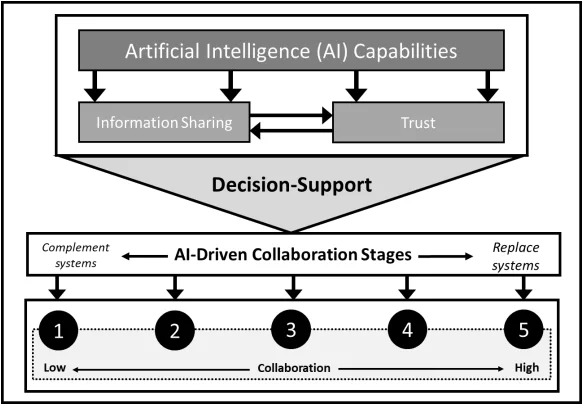Die Integration von KI transformiert das Management und die Zusammenarbeit in Lieferketten. Vertrauen und Informationsaustausch spielen dabei eine entscheidende Rolle. Doch wie genau verbessert KI diese beiden Aspekte und steigert die Effizienz der Lieferkette? Die Studie „Künstliche Intelligenz für die Zusammenarbeit in der Lieferkette: Auswirkungen auf Informationsaustausch und Vertrauen“ von Weisz et al. (2024) untersucht diesen Wandel. Das Forschungsteam stellt ein fünfstufiges Rahmenwerk vor, das zeigt, wie KI die Kooperation in Lieferketten verändert.
The role of information sharing and trust in AI-driven supply chains
Informationsaustausch wird oft als das Rückgrat erfolgreicher Lieferkettenkooperationen betrachtet. Wenn Unternehmen Daten effektiv austauschen, führt das zu besserer Koordination, schnelleren Reaktionszeiten und reduzierten Kosten. Vertrauen spielt jedoch eine ebenso wichtige Rolle, da Unternehmen eher bereit sind, wertvolle Informationen zu teilen, wenn ein solides Vertrauensfundament besteht. Im Kontext von Lieferketten entwickelt sich Vertrauen über die Zeit, was tiefere Zusammenarbeit ermöglicht. Weisz et al. betonen, dass trotz technischer Fortschritte „echte Zusammenarbeitsprobleme weiterhin bestehen“, da der Aufbau von Vertrauen ein langfristiger Prozess ist. Die Studie hebt auch hervor, dass viele Unternehmen nach wie vor strategische Kooperationen vermeiden und den Informationsaustausch auf eine transaktionale Ebene beschränken.

How AI improves information sharing and trust in supply chains
AI has the potential to radically transform collaboration in the supply chain by addressing the challenges of trust and information sharing. Weisz et al. present a framework that categorises the role of AI in improving supply chain collaboration into five stages:
1. Complementary AI applications in supply chains
In the early phases of AI integration, AI complements existing systems. Examples include chatbots and basic automation tools that provide real-time insight into stocks and shipments. Trust is still low at this stage and AI mainly serves as a support tool rather than taking over supply chain management.
2. Supplementary AI applications for the optimisation of supply chains
In this phase, AI begins to support decision-making processes by automating tasks such as data input and analysis. Information sharing becomes more efficient and trust between supply chain partners begins to grow as they rely on AI to predict demand, optimise inventory and suggest solutions based on past data.
3.Coollaborative AI applications to promote cooperation in supply chains
In this phase, AI takes on a more active role by facilitating collaboration through real-time data sharing and predictive analyses. Partners in the supply chain can make joint decisions and optimise inventory and transport planning with the help of AI-driven tools.
4. Autonomous AI applications for efficient supply chain processes
With increasing trust in AI, the systems take over important decision-making processes autonomously. AI automatically shares data, routes shipments and adjusts production plans based on real-time demand estimates. Supply chain partners collaborate on the basis of shared data and the role of AI becomes more prominent in the management of operations.
5. AI replaces traditional systems in supply chain management
In the final phase, AI completely replaces existing systems and automates the entire supply chain process from start to finish. At this stage, trust in AI is high and companies benefit from continuous real-time optimisation, predictive analytics and fully autonomous decision-making systems that dynamically adapt to changes in the supply chain.
Implikationen für Manager
Das Rahmenwerk bietet wertvolle Orientierung für Manager im Lieferkettenmanagement. Es hilft, den aktuellen Stand der KI-Integration zu bewerten und die nächsten Schritte zu planen. Die Studie betont die Bedeutung menschlicher Aufsicht. Risiken wie voreingenommene Datensätze oder algorithmische Fehler erfordern eine kontinuierliche Kontrolle. Zudem müssen Unternehmen Vertrauen in KI-Systeme aufbauen. Transparenz und Nachvollziehbarkeit sind essenziell, um Akzeptanz zu fördern und Bedenken auszuräumen.
Die Zukunft der KI in Lieferketten
KI hat das Potenzial, Lieferketten grundlegend zu verändern. Dennoch gibt es Herausforderungen. Der Übergang von menschlicher Zusammenarbeit zu KI-gesteuerten Systemen erfordert ein tiefes Verständnis für Vertrauen und Automatisierung. Die Rolle der menschlichen Aufsicht bleibt in Hochrisikobereichen wie der Nachfrageprognose essenziell. Das fünfstufige Rahmenwerk dient als Leitfaden für Unternehmen und Forscher. Es zeigt, wie KI Vertrauen und Zusammenarbeit in der Lieferkette optimieren kann. Unternehmen müssen agil und offen für neue Technologien bleiben, um wettbewerbsfähig zu bleiben.
For a detailed discussion of the original research, you can view the full study here .
For further information, please contact contact@circly.at or use our contact form https://www.circly.at/en/contact to book an appointment.
Conclusion
Die Studie von Weisz et al. (2024) zeigt das transformative Potenzial von KI für Lieferketten. Das fünfstufige Modell verdeutlicht die Entwicklung von KI von einer unterstützenden Funktion hin zu autonomen Steuerungssystemen. Der erfolgreiche Einsatz von KI erfordert technologische Fortschritte sowie das aktive Vertrauen der Unternehmen. Trotz steigender Automatisierung bleibt menschliche Kontrolle essenziell, um Risiken zu minimieren und Prozesse zu optimieren. Unternehmen müssen flexibel und transparent agieren, um die Vorteile von KI in einer datengetriebenen Welt voll auszuschöpfen.